Having left Lincoln, following the route that the procession taking the body of Eleanor of Castile to Westminster Abbey, in today’s post, I am visiting Grantham, Stamford and Geddington, marked with blue circles in the following map, which shows the overall route:
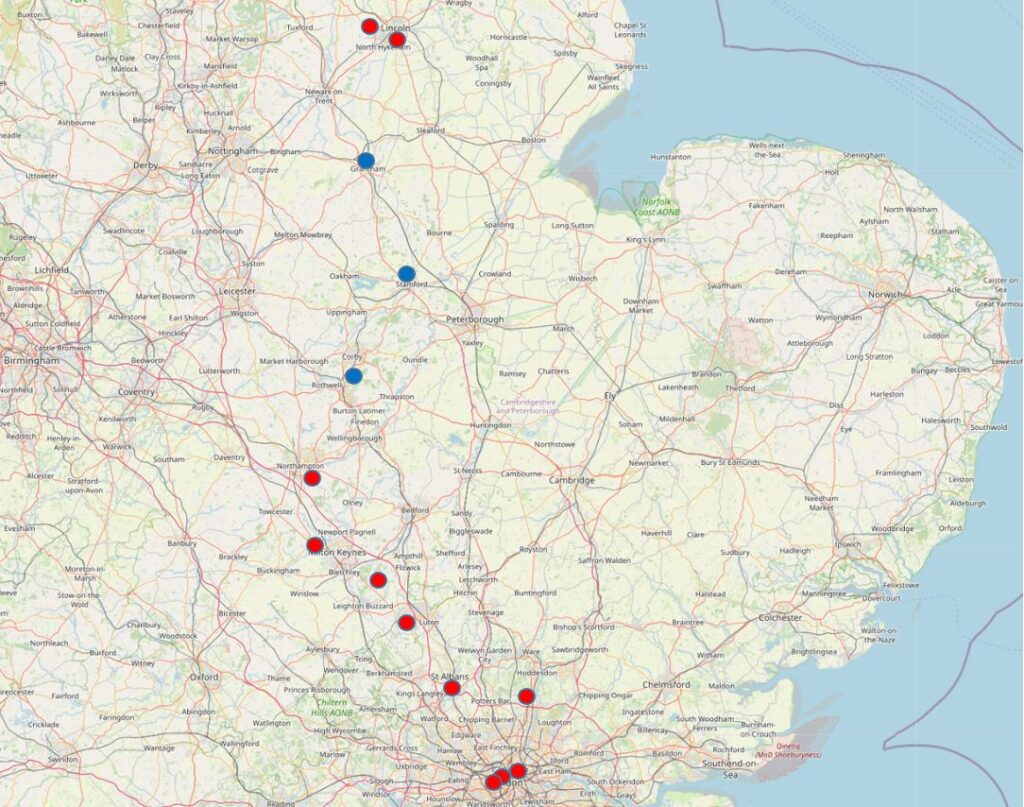
In two of these places, the original cross was destroyed many years ago, however I also find the most complete example of an original Eleanor Cross.
I also find three interesting places, the site of some of my father’s photos, and what is believed to be the only living pub sign in the country.
The first stop is at:
Grantham
Grantham, roughly 25 miles to the south of Lincoln, was the first of the overnight stopping places on the journey to London.
There is no exact location of the cross that was built to mark the overnight stop, or where Eleanor’s body rested for the night. English Heritage states that the cross was in the widest part of the High Street, by St Peter’s Hill.
Eleanor’s body may have rested at the parish church of St Wulfram, or in the Grey Friars property where the Franciscans had recently settled. The Victoria County History of Lincoln, published in 1906 records that Edward I “gave these friars 12s. 8d. for two days’ pittance and 21s. for three days’ pittance”, so they must have been in favour and therefore they could have looked after the body.
The Eleanor Cross was destroyed during the Civil War in the 1640s, and there are no confirmed remains of the cross to be seen, however English Heritage state that some of the stones from the Eleanor Cross may have been used to repair / rebuild Grantham’s market cross, so this was the first destination on arriving in Grantham.
Grantham’s market cross seen from the main street running through the town:
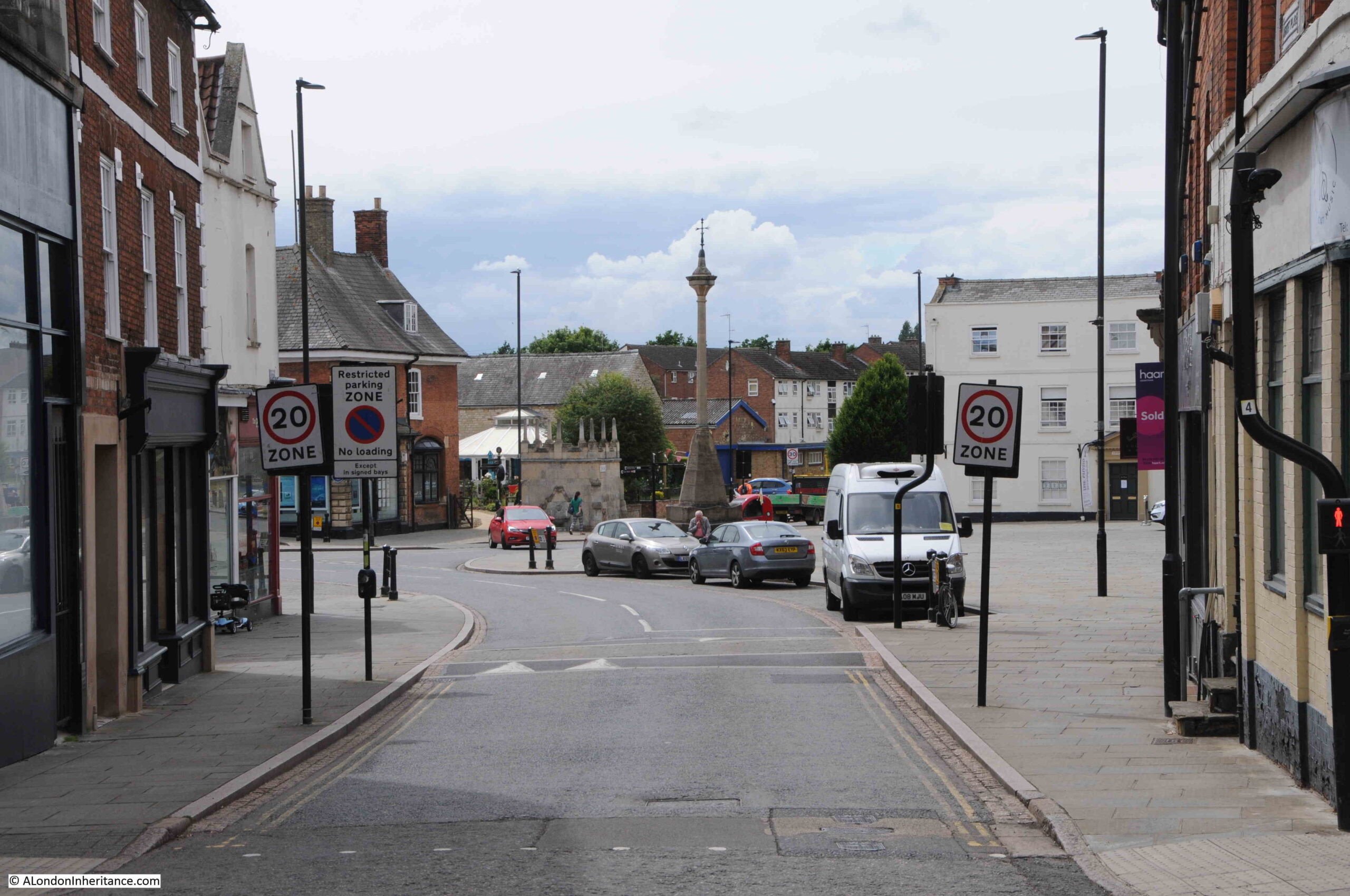
My father visited Grantham on the 25th of July 1952, almost 70 years to the day of our visit. Grantham has been on the list for a visit so I can track down the location of his photos, and the project to follow the route of the 1290 procession also provided the opportunity for some then and now photos.
At the road junction from where I had photographed the market cross shown above, is the Angel Inn. A plaque on the wall by the Grantham Civic Society states that the gatehouse inn dates from the 15th century and that King Richard III received the Great Seal here in 1483, and that over the years other monarchs have also stayed in the inn.
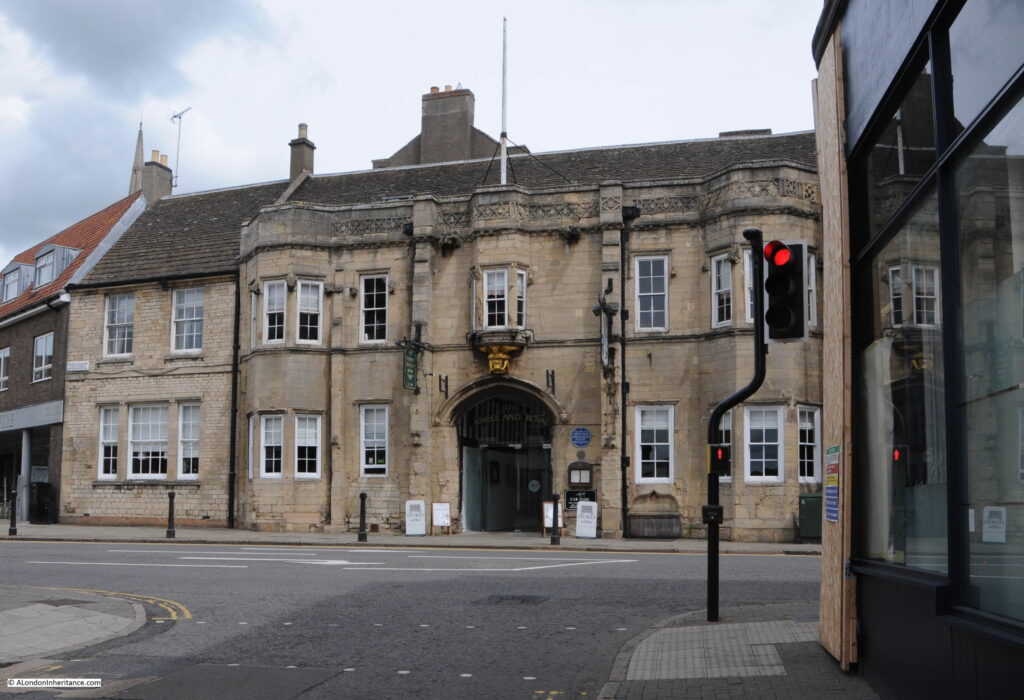
Seventy years ago, my father took a photo of the same view:
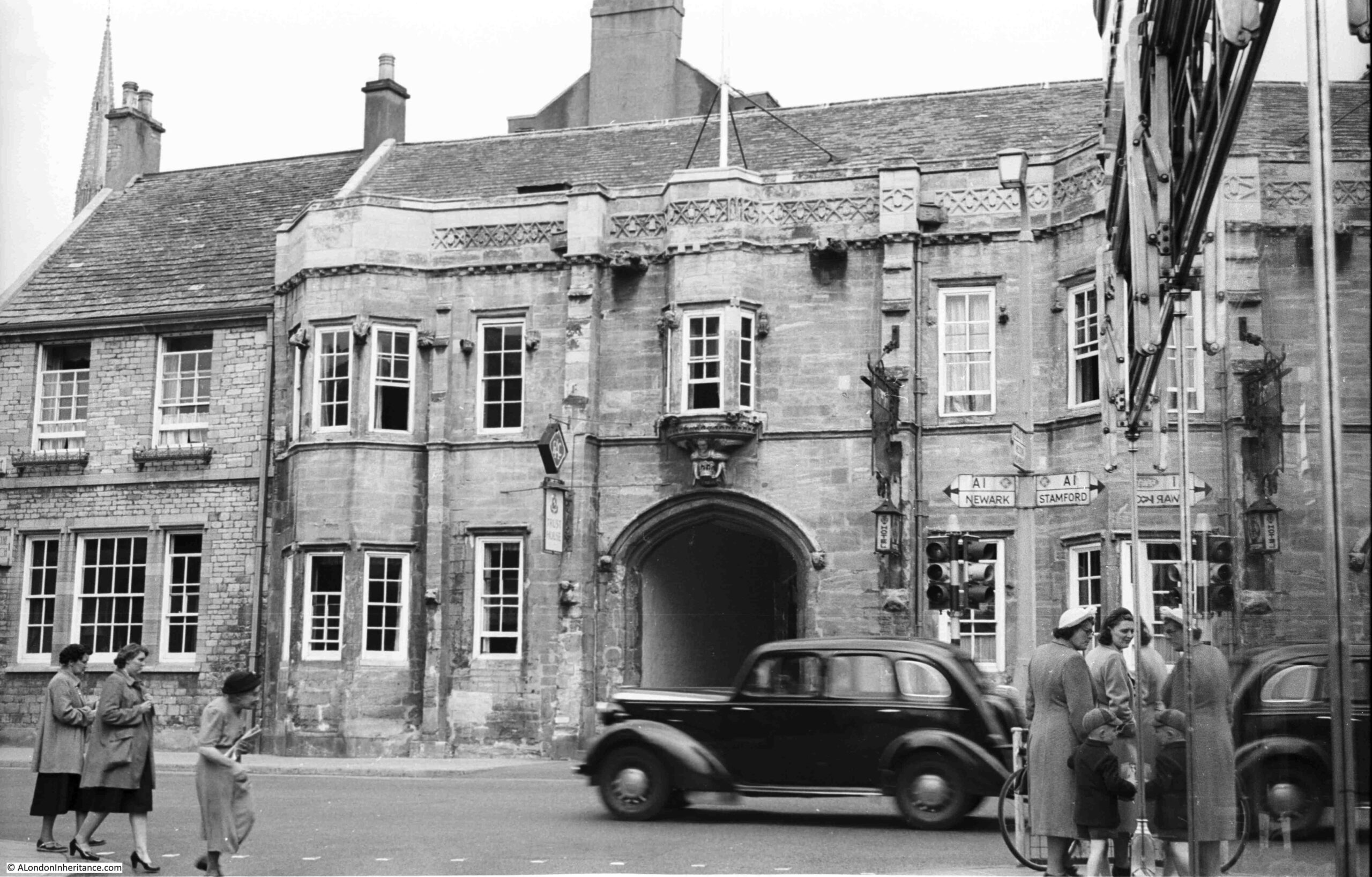
The road that runs through Grantham, and is the road in front of the Angel Inn in the above two photos is now the B1124, however if you take a look at the direction sign in the photo, this was originally the A1, or the Great North Road – the main road to the north from London.
If I look at a London street atlas of the time, the A1 is shown starting at the junction of St Martin’s Le Grande and Cheapside, and Aldersgate Street is still marked as the A1. Detail of the 1952 direction sign:

Walking down to the market cross, and it is located in a large open space, which at one time held the town’s local market.
The cross is Grade II listed, and along with the surrounding space are classified as a scheduled ancient monument, and intriguingly the listing states that this does not cover the surrounding paving stones, but does cover the ground below due to the lack of development probably preserving ancient remains from the construction of the cross.
The cross is believed to be medieval in origin, but with later repairs and restorations, when some of the stone from the Eleanor Cross may have been used.
View of Grantham’s market cross:
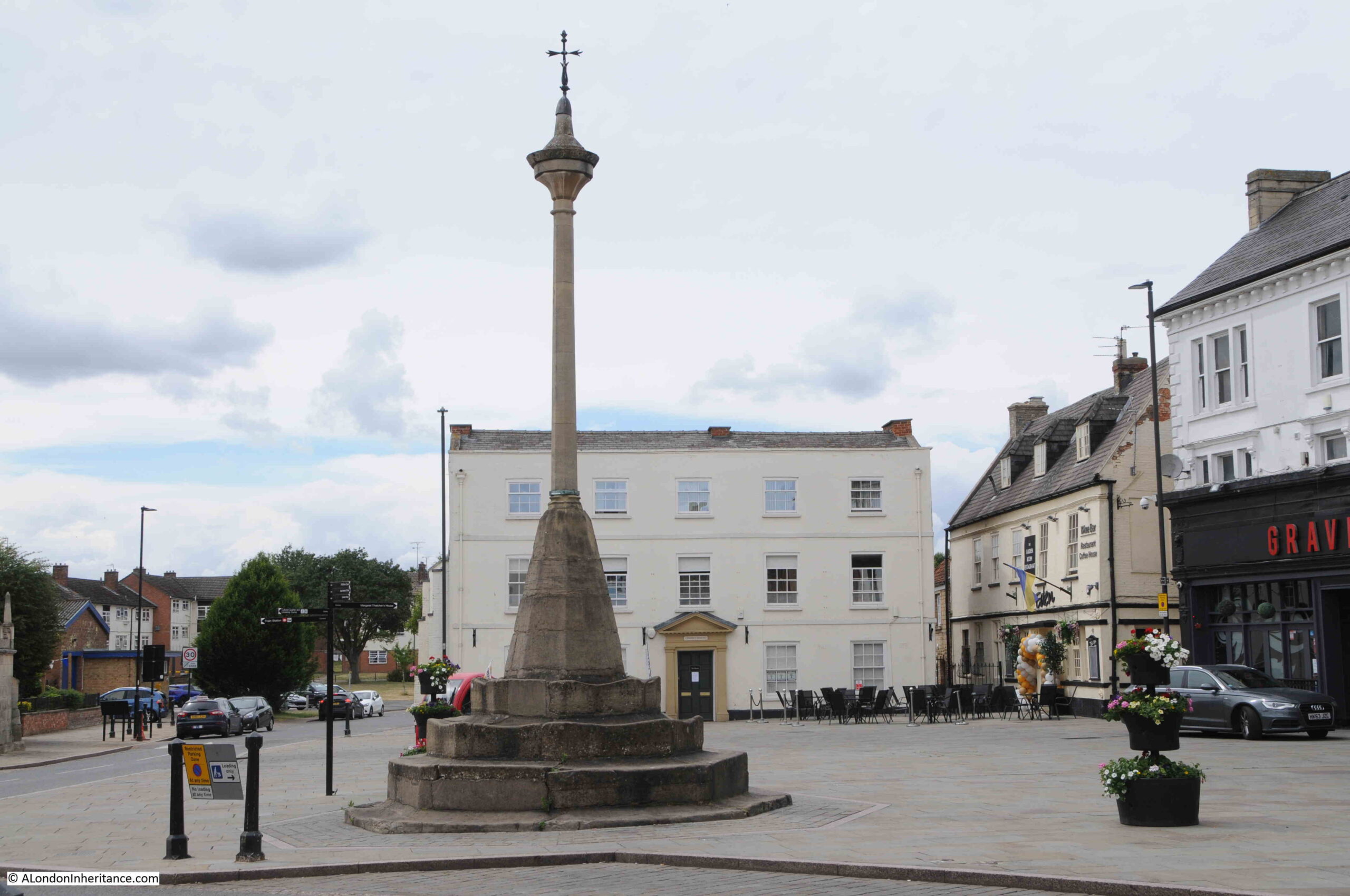
On his 1952 visit to Grantham, my father also photographed the market cross, and the photo below shows roughly the same view as my 2022 photo above.

In 1952, the large building behind the cross was the Blue Lion Hotel. Today, the building appears to be a private house. The van to the left of the cross was Welbourns Ices and Snacks.
A minor detail of how things change, the cross on the top of the market cross appears to have turned by 90 degrees at some point over the last 70 years.
Another feature that my father photographed near the cross was a water conduit:
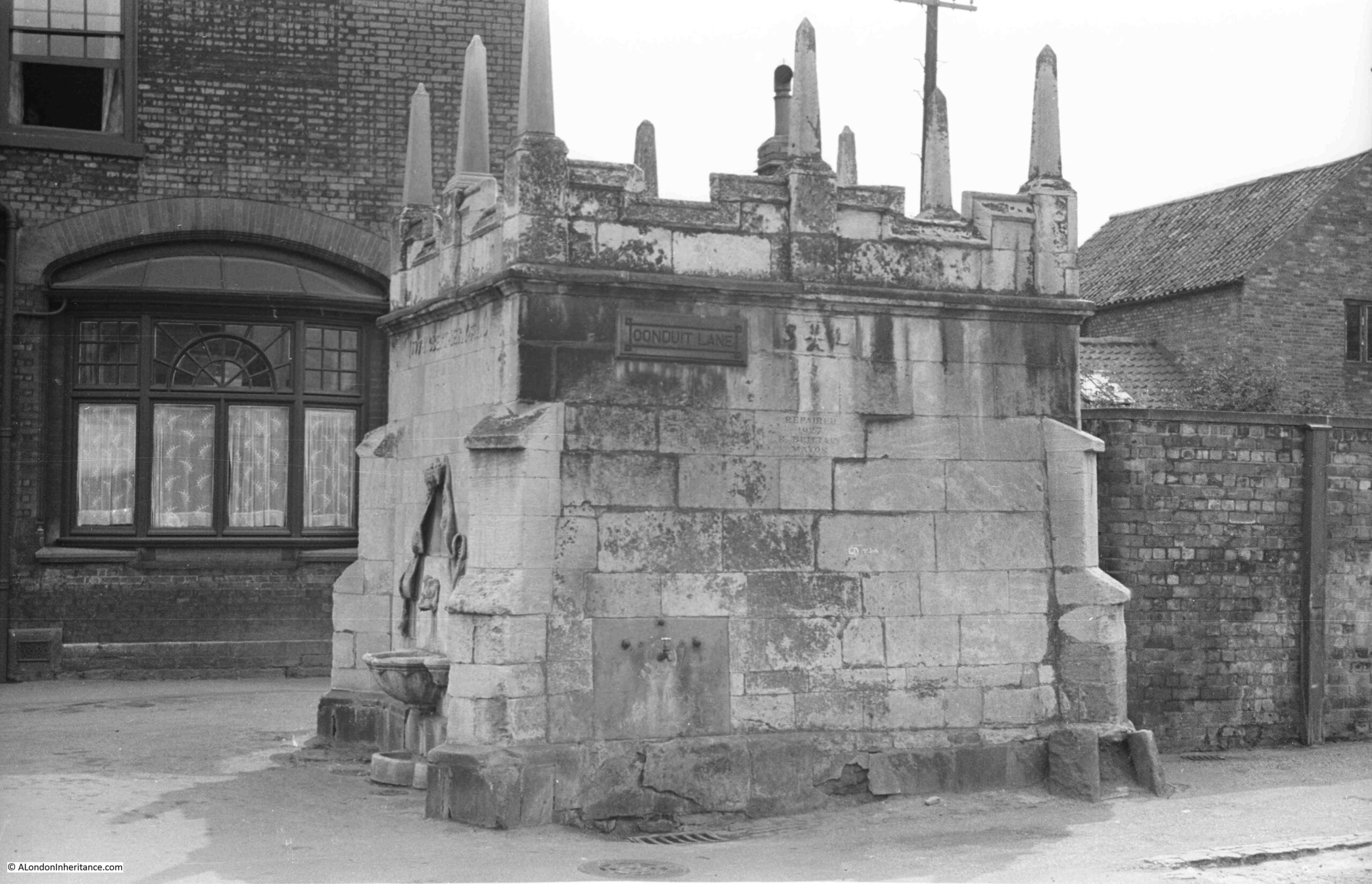
A conduit is a building that contained a cistern, or holding tank for water, and allowed water to be taken via a form of tap on the building by the local population.
The conduit has its origins with the Grey Friars who purchased the land around a spring outside of Grantham and piped the water to their property.
In 1597 the water supply was extended by pipe to the conduit in the market place. The conduit and pipeline was constructed by the Corporation of Grantham.
The conduit has seen many repairs since it was built, in 1927 the roof was replaced, along with three of the distinctive pinnacles.
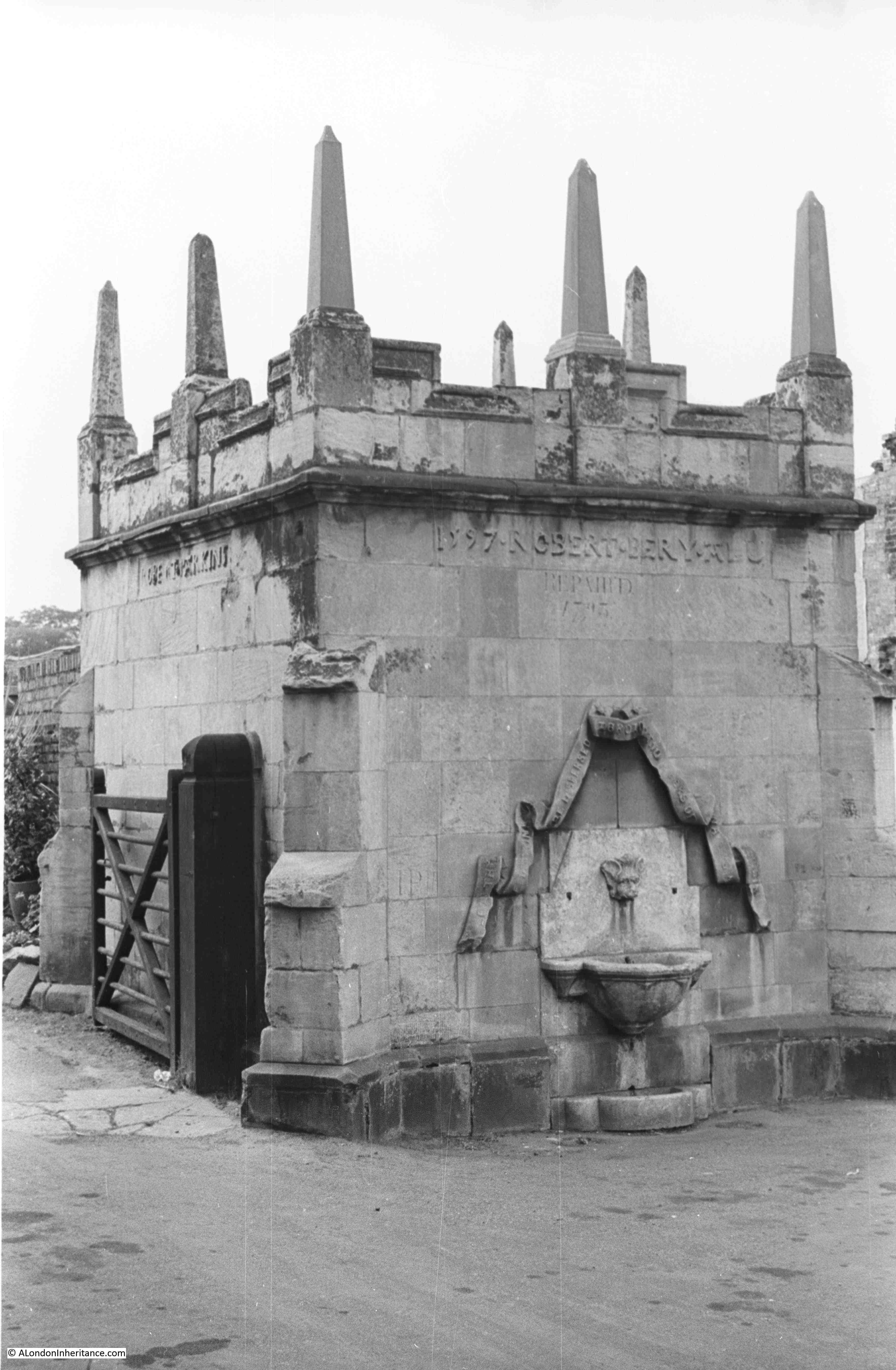
The conduit today:
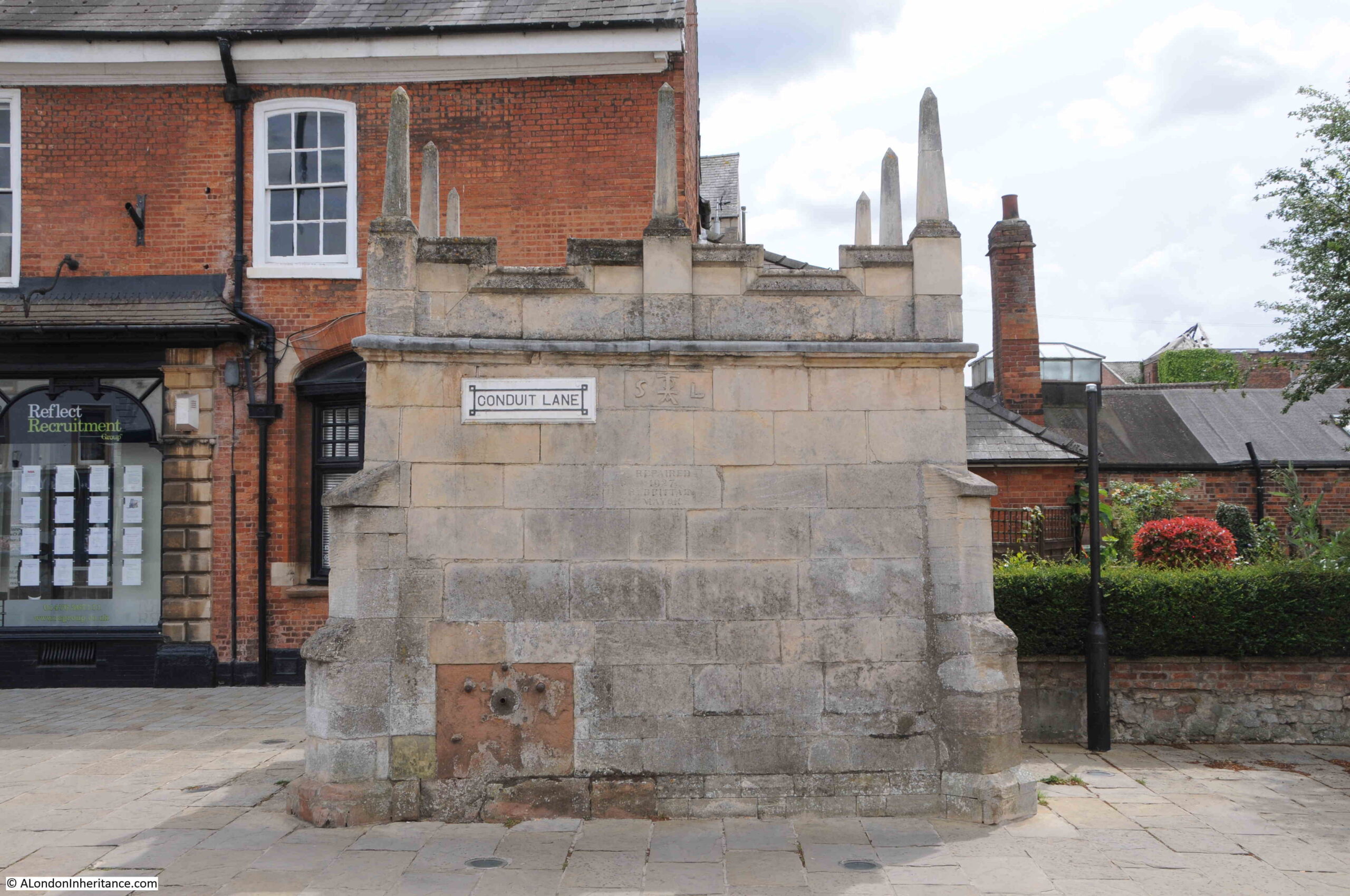
View from the front of the conduit, with the date near the top, and the bowl below where water was drawn off from the conduit:
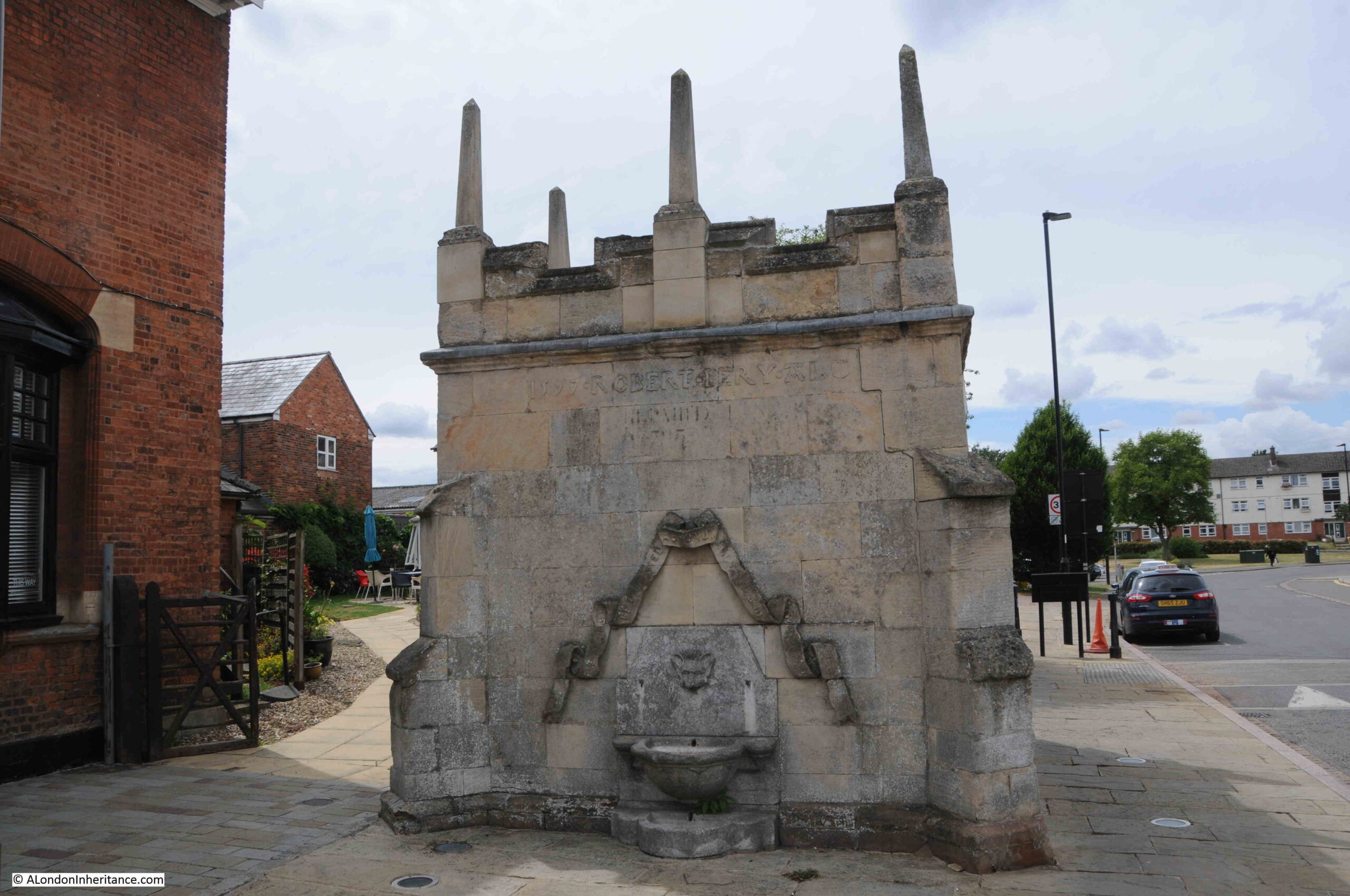
Rear of the conduit in the corner of the market place with the cross in the background:

Grantham has a number of interesting historical features, and there was a pub I wanted to find, so we went for a walk.
A brick building on the corner of the street down to the market cross has a plaque:

The plaque records that a parcel of land was given to the “Commonality of Grantham” by Richard Curtis in 1494:
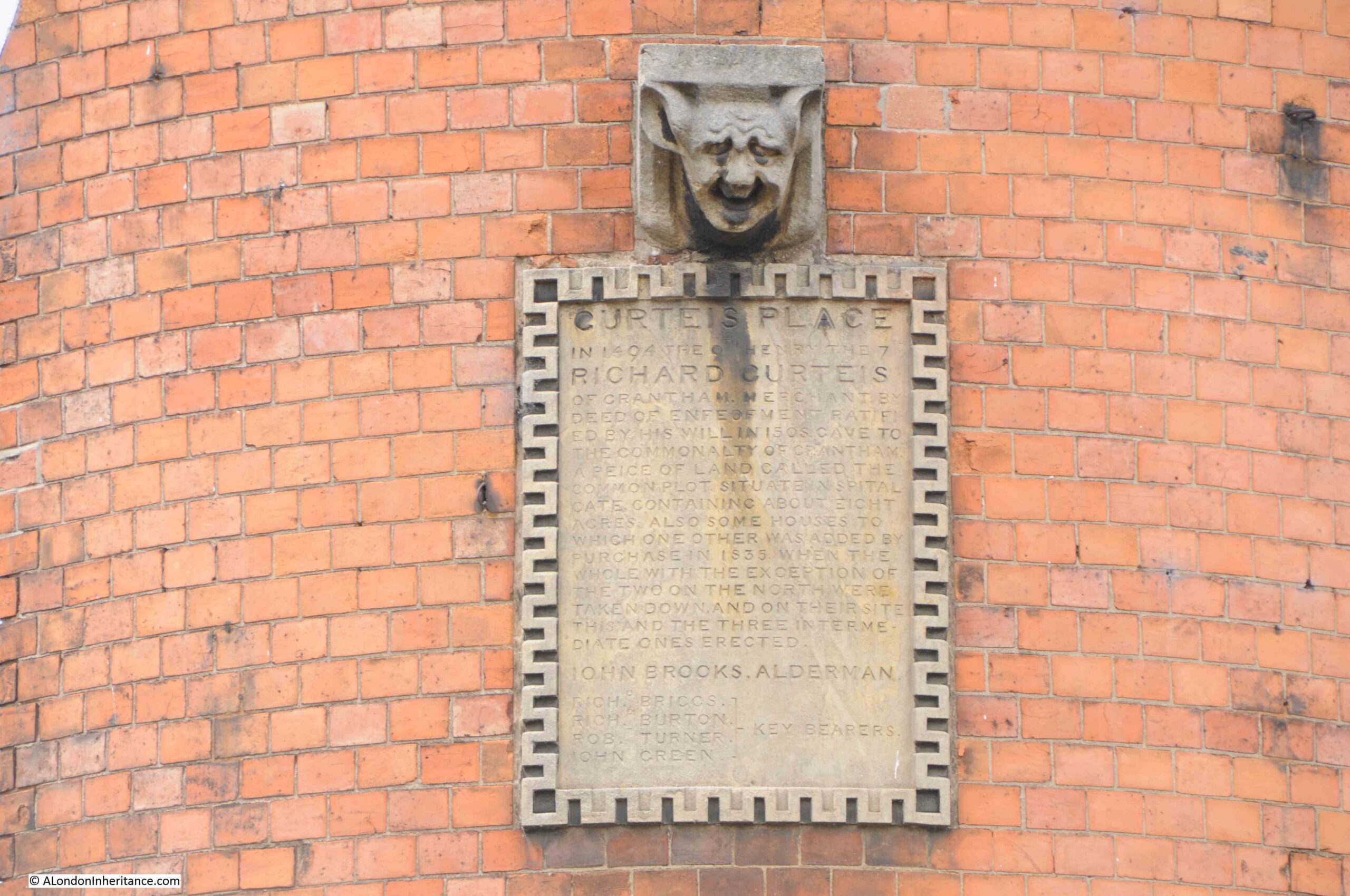
An end of terrace house has a blue plaque that records that the early antiquarian Rev. Dr. William Stukeley lived in a house near the site of the plaque between 1726 and 1730:
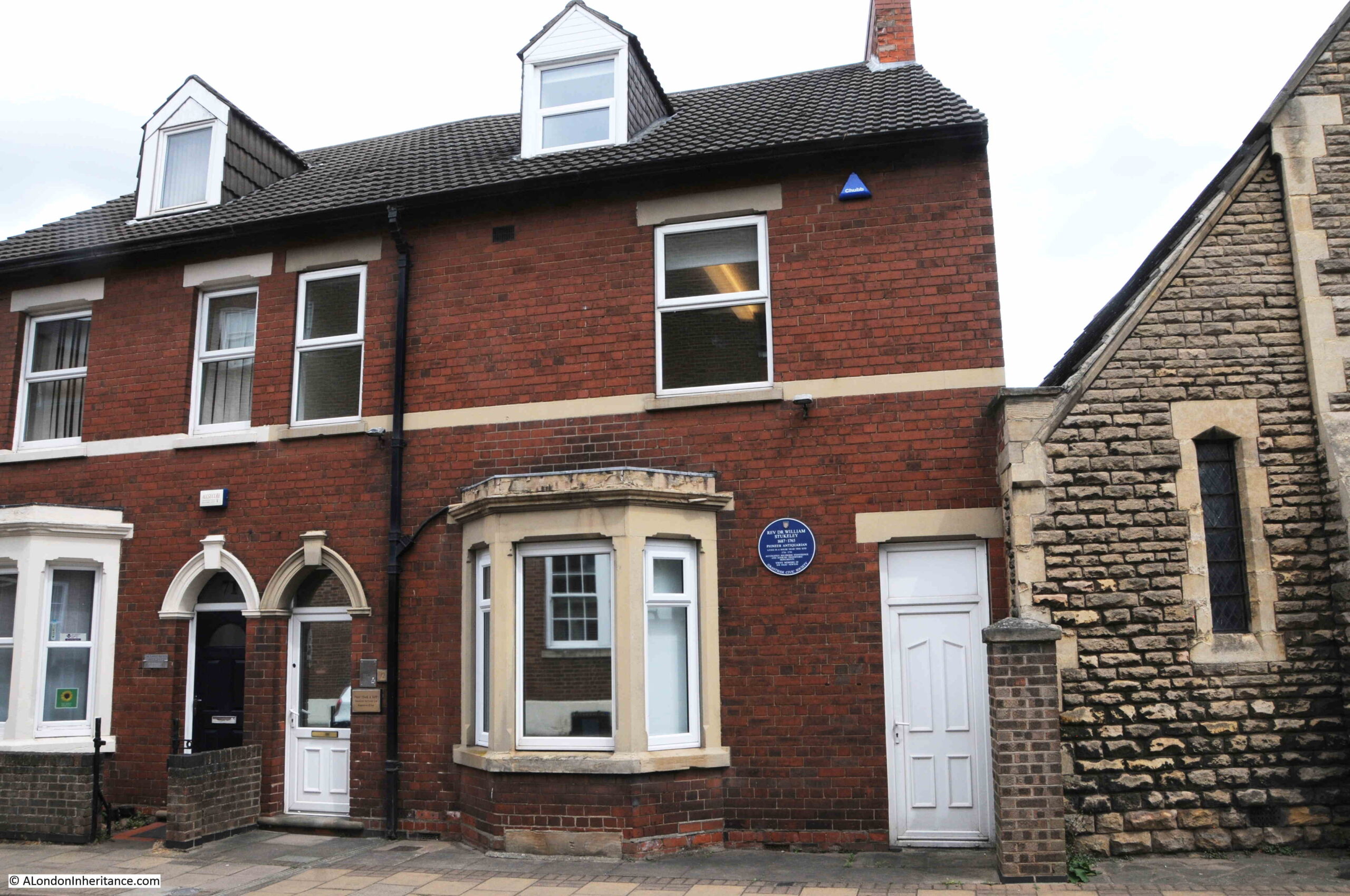
William Stukeley was the first to accurately record Stonehenge, and the stones at Avebury, and he also wrote a memoir of Grantham resident Isaac Newton.
Another of my father’s photos in Grantham was of a pub which was, and I believe still is, known as the only pub in the country with a living pub sign.
This is the Beehive in 1952:

The Beehive has a beehive in the tree directly outside the front of the building. It was visible in my father’s photo above, however in my 2022 photo from the same side of the tree, it was covered with leaves:

View from the other side of the tree:

Not really visible in my 2022 photos, but there were bees flying within the branches of the tree.
The same view in 2022, where the beehive is just visible to the left of the tree:
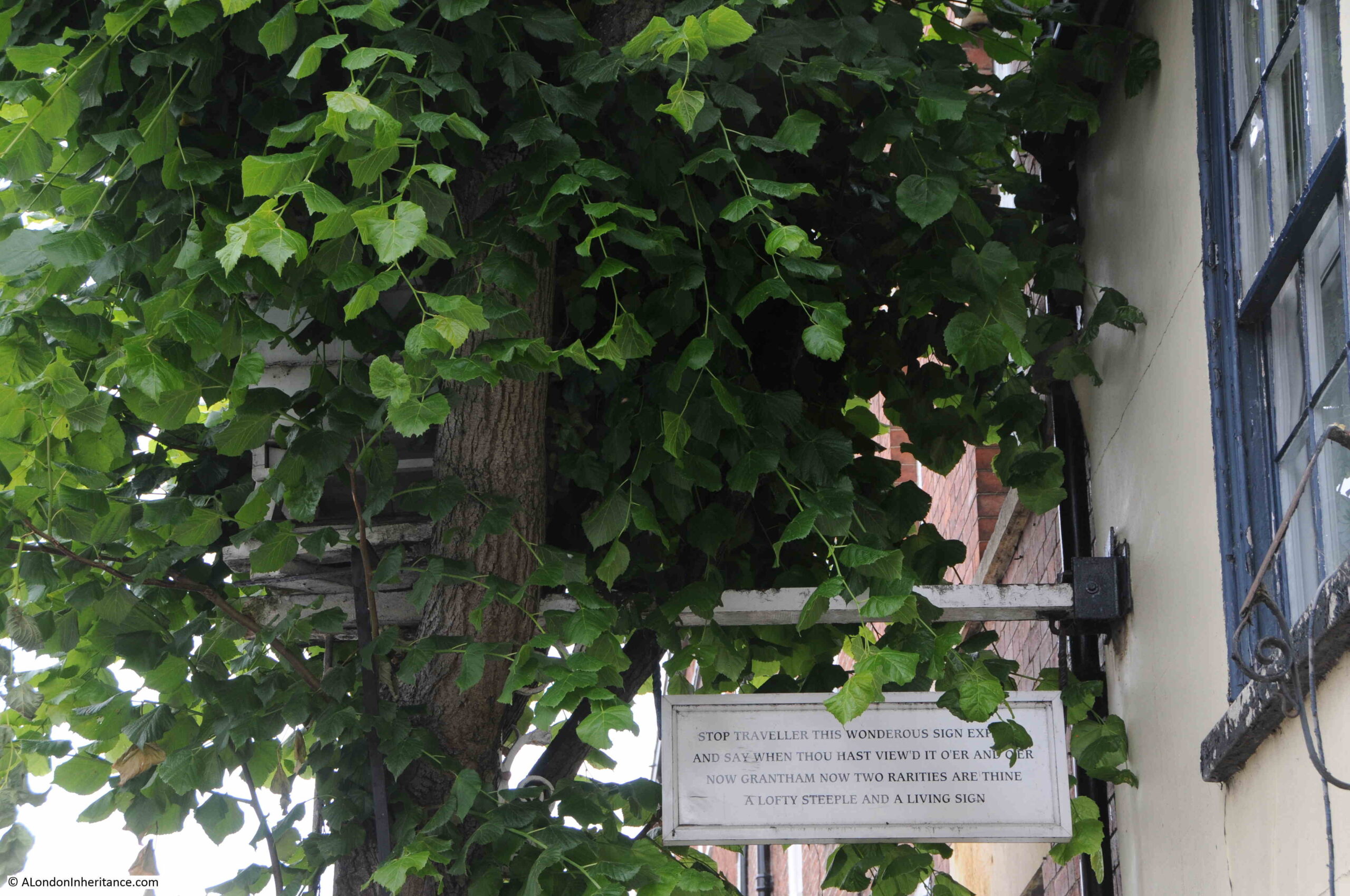
The sign was restored in 2017, and reads: “Stop traveler this wonderous sign explore and say when thou hast view’d it o’er and o’er now Grantham now has two rarities are thine a lofty steeple and a living sign”.
The Beehive pub sign:
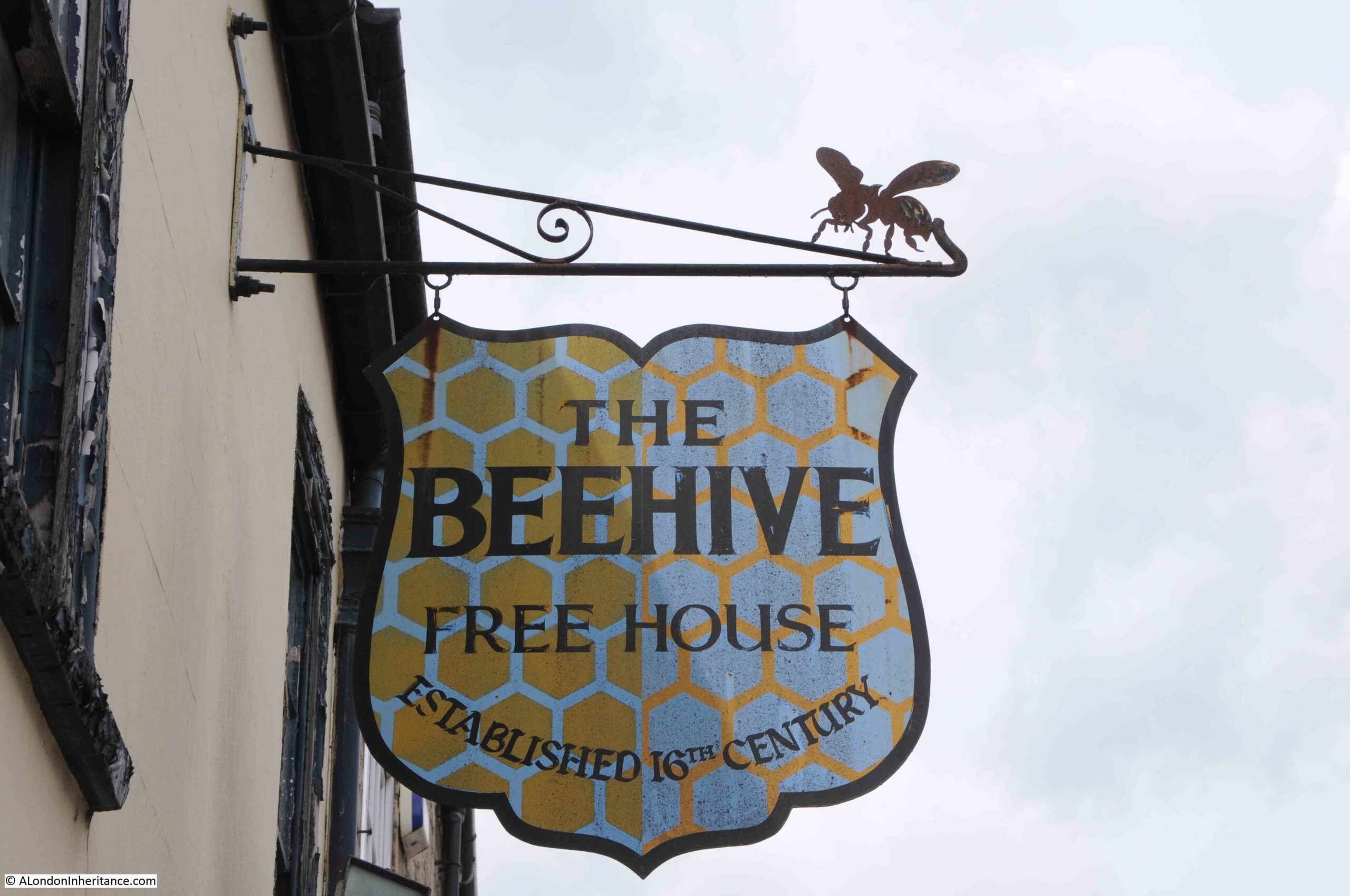
I have found various dates for the age of the pub. The restoration of the sign was by the Grantham Civic Society, and a newspaper article in the Grantham Journal states that the pub dates back to at least 1783 when the pub was drawn by John Claude Nattes, with the beehive being in existence at that time.
My father took the following photo of the pub in 1952:

Visiting the sites photographed by my father has taught me that you cannot always believe what you see. The following photo shows the Beehive pub in 2022. in the above 1952 photo is appears to be only the smaller part on the left of the pub in 2022. In 1952 there was a building with a very different frontage to the right of the first ground floor window.

I do not know if the building on the right of my father’s photo was part of the pub, but it appears to have been a very different building to the right half of the pub today.
A recent statue in Grantham has resulted in some rather mixed feelings – the statue of Margaret Thatcher, who was born in Grantham in 1925:
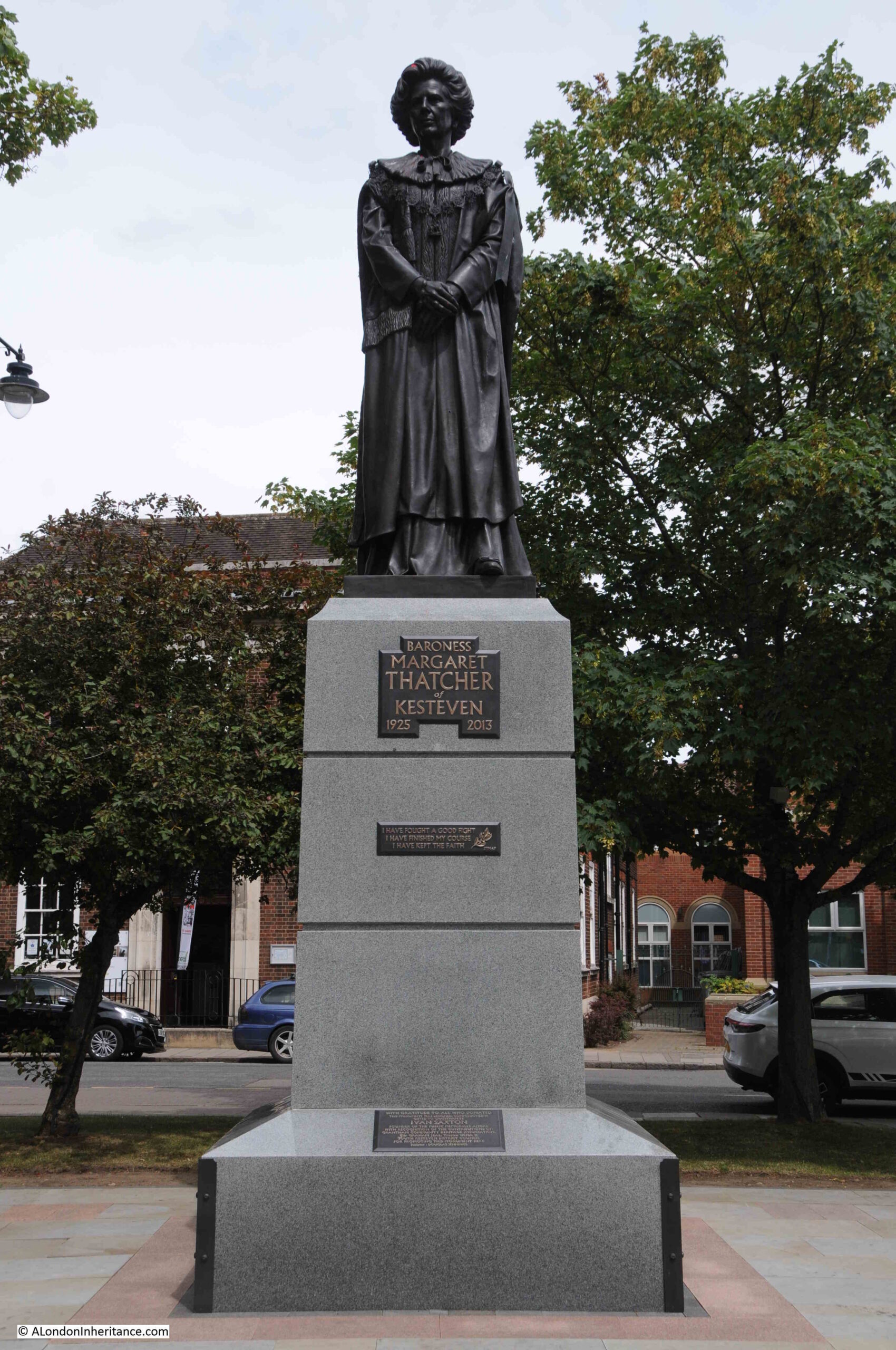
Soon after being unveiled, people started throwing eggs at it, and an enterprising individual started selling eggs in front of the statue. CCTV was installed and there was a prosecution. The statue was very egg free on the day of our visit.
Another statue is that of Isaac Newton:
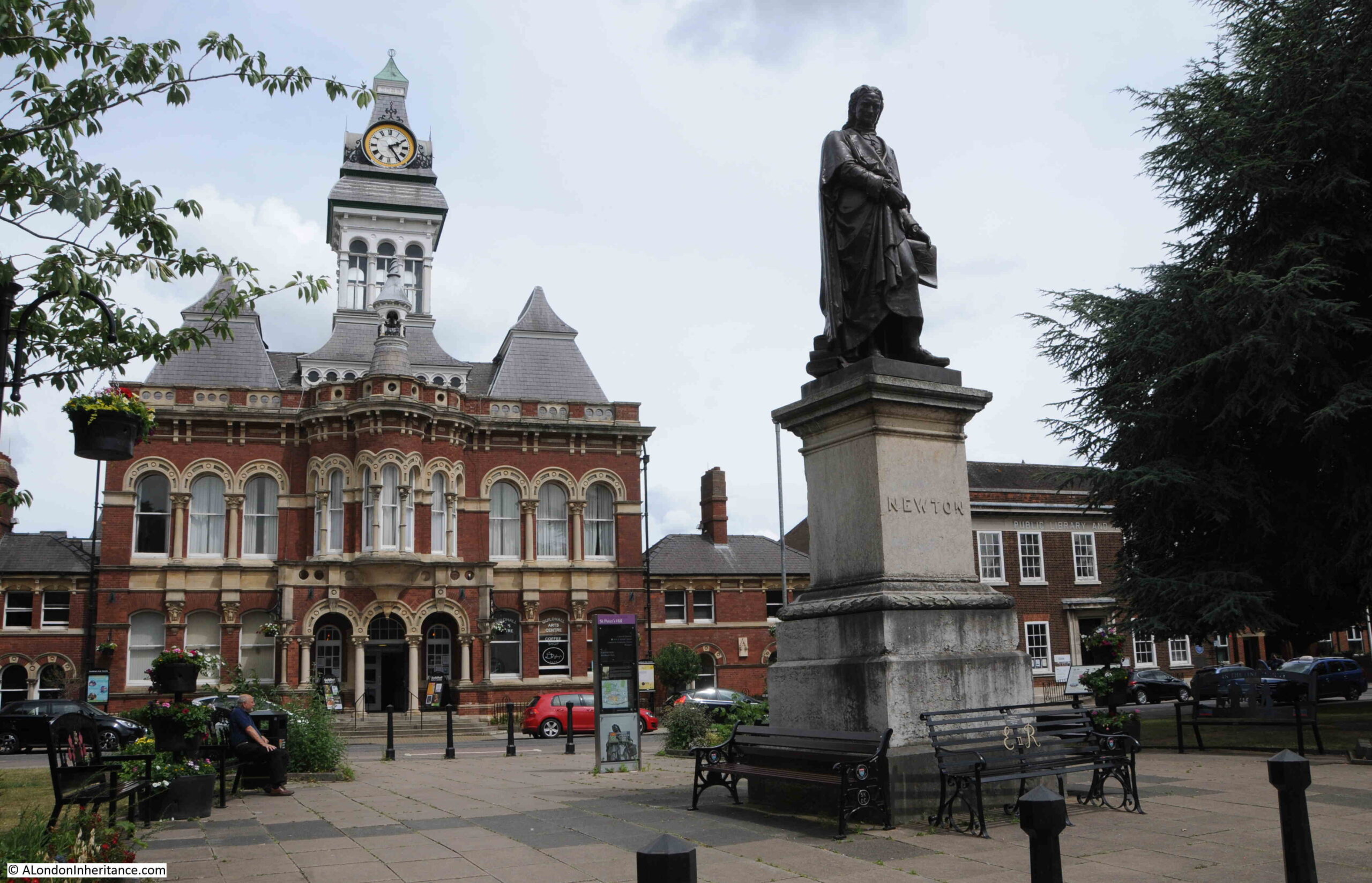
Newton was educated at the King’s School in Grantham, and today, as well as the statue, he has a shopping centre named after him:

A blue plaque can be seen to the right of The George in the following photo. The plaque states that it is on the site of a house owned by Mr Clarke, the Apothacary, and that Isaac Newton lodged in the house whilst he was attending school in Grantham between 1655 and 1660.
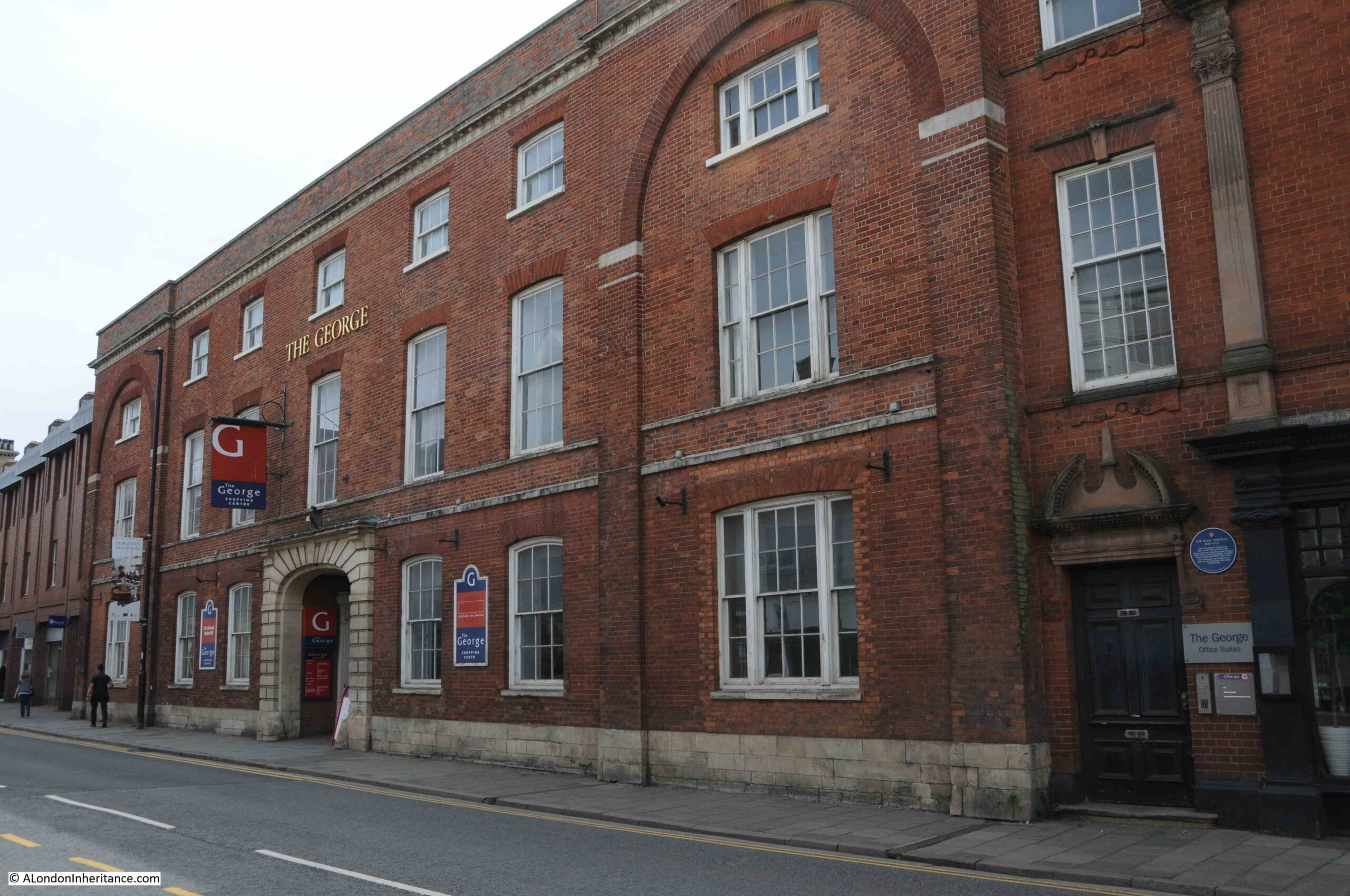
The George was built in 1789 as a coaching inn, servicing the considerable traffic that would have run through the town when the Great North Road / A1 ran through the town. It is now a shopping centre.
The next stop as the body of Eleanor was carried towards London would be further south along the old Great North Road, at:
Stamford
The Stamford Eleanor Cross was another of the those probably destroyed during the English Civil War, it seems to be the period most commonly referenced in a number of the books I have consulted.
The English Heritage page on the cross states that it is not known exactly when the cross was destroyed, although it was before the mid 18th century. The page also refers to William Stukeley recording the hexagonal steps of the cross, which is all that survived in 1745.
We have already seen a plaque to Stukeley in Grantham, which was his destination after he moved out of London. Whilst in Grantham he married, and found that his income was insufficient to support a family, and when he saw that the living of All Saints in Stamford was vacant and provided an income of £589 per annum, he used his contacts to secure the role, and moved the Stamford.
There is no confirmed location for either the original cross, or where Eleanor’s body was rested overnight whilst in Stamford.
In 2008. to commemorate the original Eleanor Cross, a representative spire was installed in Stamford’s Sheep Market:

Part of the spire has a spiral of roses. These were the personal badge of Edward 1st.
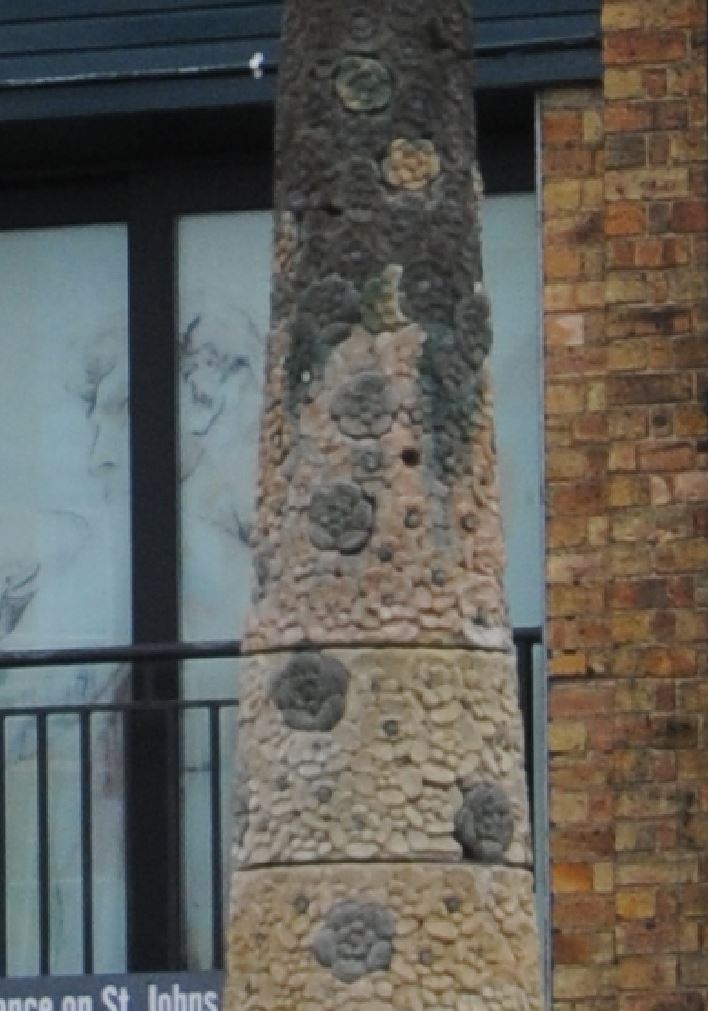
Another view of the spire in Stamford’s Sheep Market:
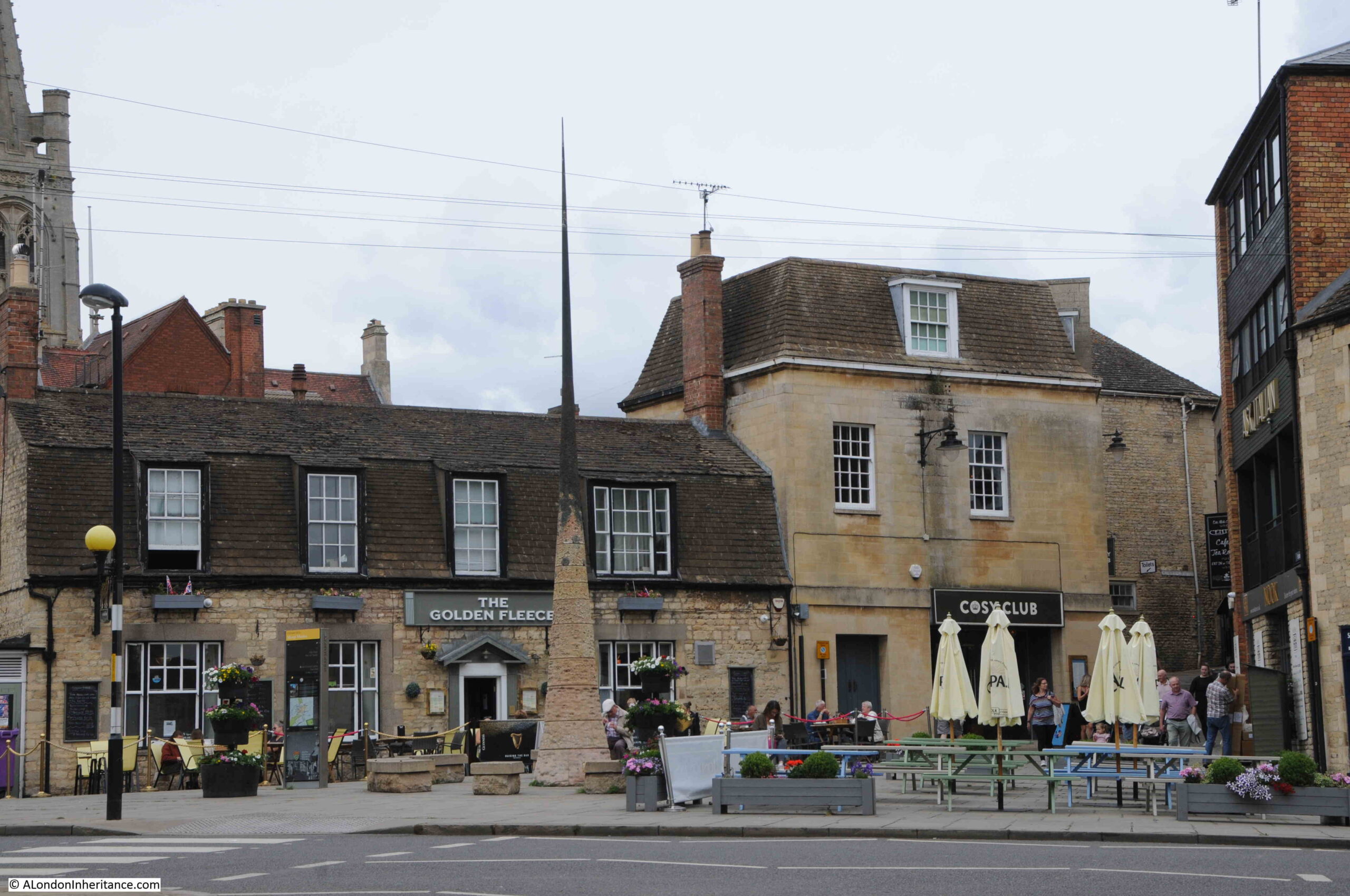
Stamford is another very old town, and like Grantham, it was on the old Great North Road / A1, which now bypasses the town, and the high street is now pedestrianised which makes for a very pleasant environment:

Stamford shows its age through the buildings that line the streets of the town. Many built of local stone, with the following house dating from 1655 according to the small plaque above the upper window:

The vacuum store:

Stamford is roughly 22 miles from Grantham, and this seems to be about the average distance travelled by the procession carrying Eleanor’s body in a day.
Eleanor died at the end of November, so the procession to London took place during the first weeks of December. These were weeks of short days and long nights. possibly cold and wet with poor road conditions so this must have been a difficult journey.
Nightly stops needed to be at a place where Eleanor’s body could be rested in a suitable place, and that there were appropriate lodgings for Edward I, and those who accompanied him on the journey to London.
The route also needed to avoid major obstacles such as rivers, and this is one of the reasons why Stamford was on the route, as in Stamford, the Great North Road crossed the River Welland, and still today, with the exception of the A1 by-pass of the town, the route over the Welland is the only crossing for some distance.
The following photo shows the bridge over the Welland on the approach into Stamford:

View from the bridge to the west, where the River Welland splits into two before joining again in a couple of miles:

Looking in the opposite direction, away from the town, along the old Great north Road:

This stretch of the road is unique in retaining a wooden inn sign that stretches across the road. This is for the George Hotel which is on the right in the above photo.
The George is an old inn, again one of many coaching inns that were on the old Great North Road. The sign across the road, as well as the current view of the George dates from the 18th century.
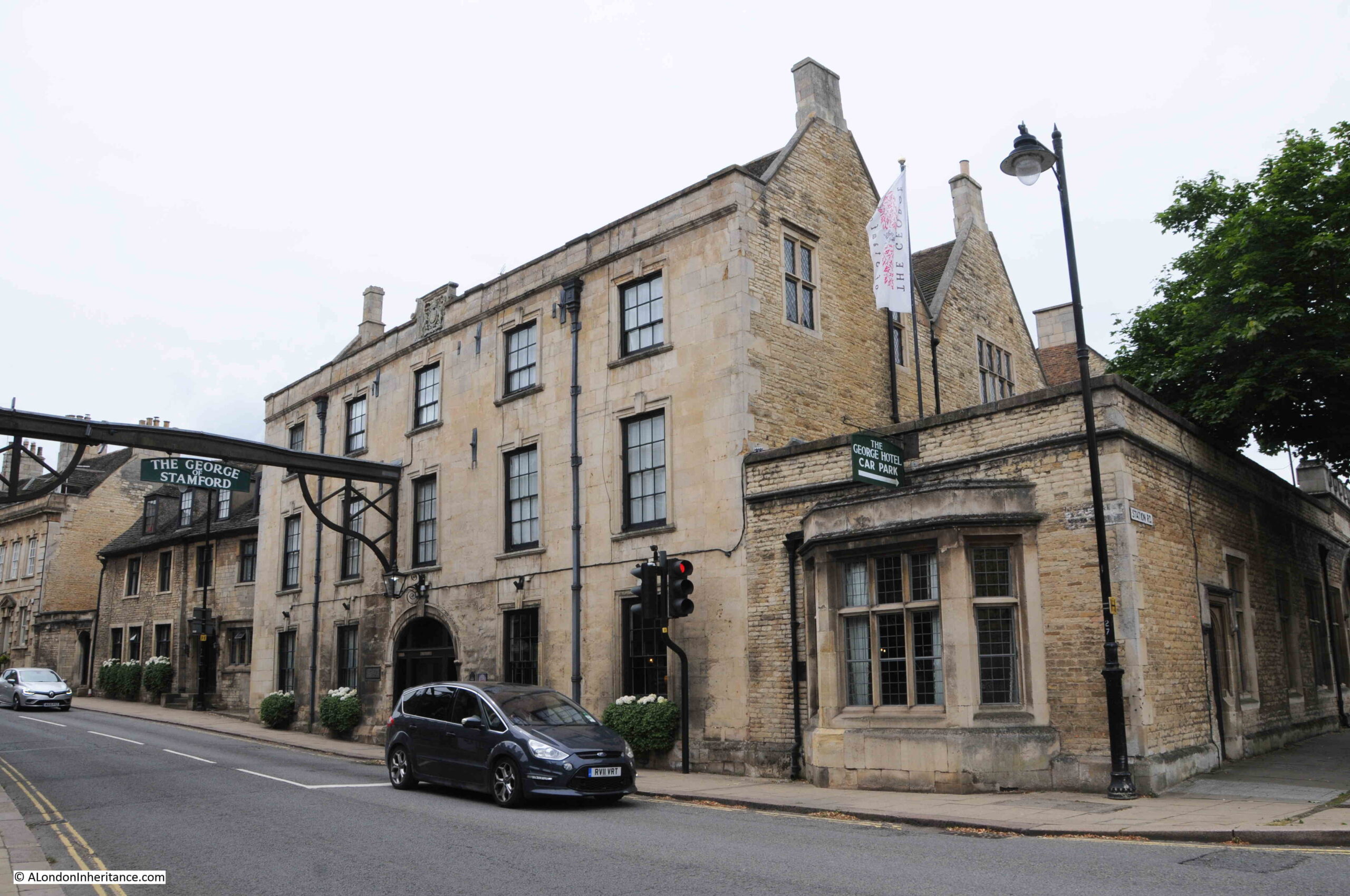
The George is certainly on the site of a centuries old inn, however the George’s claim that an ancient hostelry existed on the site in 947 is difficult to confirm. A hostelry could well have been next to a key river crossing on the main road from London to the north for many centuries.
A plaque on the hotel states “In medieval times when the house of the Holy Sepulcher stood on this site knights of Saint John of Jerusalem were entertained here. In the garden at the rear Crusaders in their black robes with white cross walked and talked. The gnarled mulberry tree dates from the time of James I. The main block of the hotel was erected in 1597 by Lord Burghley, Lord High Treasurer to Queen Elizabeth I. At least three kings and many other famous travelers have stayed here”.
Next to the George are a row of almshouses that have their origins back in the 12th century, when they formed part of the medieval hospital of St John the Baptist and St Thomas:

For the next stop on the route to London, the procession left the Great North Road and headed across country to a small village, where I finally find a surviving Eleanor cross, at:
Geddington
The procession arrived at Geddington on the 6th of December 1290. Geddington is a small village, and the reason for choosing the village as a stop is that a royal hunting lodge was close by, just north of the church. The lodge had been built in 1129 and was used by royal hunting parties in the local forests, indeed Edward and Eleanor had stayed at the lodge in September of 1290.
Geddington has the best preserved of all the remaining Eleanor crosses, which is located in an open space at the centre of the village:
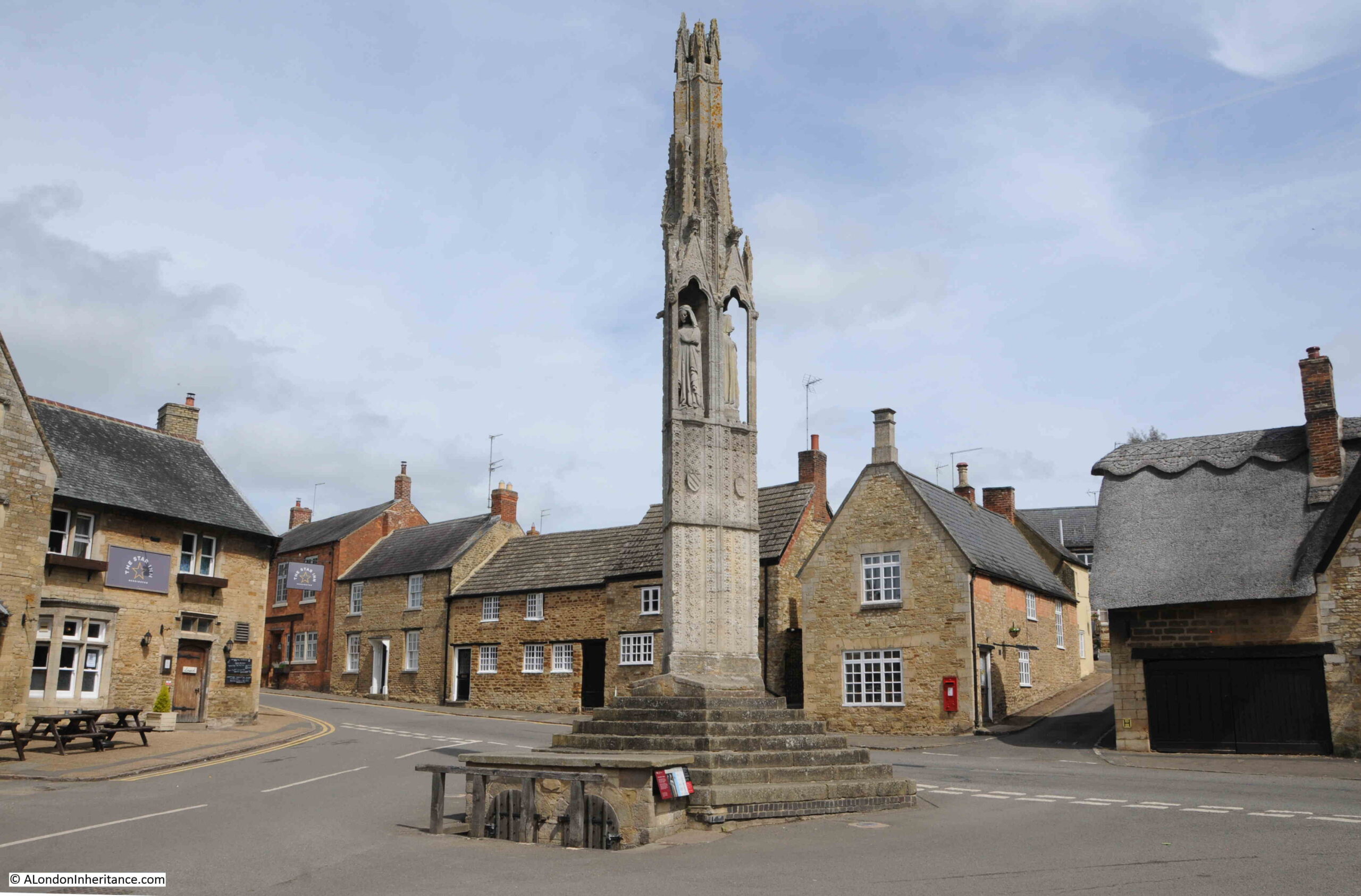
The cross has been repaired a number of times, and has been used for a rather gruesome, local custom. The book Old Crosses and Lynchgates by Aymer Vallance, published in 1933 reports that:
“Tradition says that a favourite sport of the place used to be squirrel-baiting. A sufficient number of wild squirrels having been caught for the purpose, would be turned loose in the village, where the crowds, surrounding them in a ring, with shouts and all manner of hideous noises, proceeded to hunt and beat the helpless victims to death. Sometimes the terrified little creatures would vainly seek refuge by running up the cross and trying to hide behind the pinnacles and tabernacle work. but their cruel tormentors ruthlessly dislodged them thence, pelting them with stones until they were driven forth and killed. The only marvel, in the circumstances, is that any part of the original stonework of the cross should have survived such reckless violence.”
Rather hard to believe that such a cruel activity took place in this quiet village space, however the past was a very different place.
The cross dominates the centre of the village. It is roughly 42 feet in height and can be seen from surrounding side streets, and from the raised graveyard of the nearby church:

English Heritage state that whilst Edward I stayed overnight in the hunting lodge, Eleanor’s body rested in the parish church of St Mary Magdalene:

Statues of Eleanor look out from half way up the cross:

On the body of the cross, we can see again the arms of Ponthieu and of Eleanor of Castile, along with the level of decoration on the cross:

Geddington has another treasure to find, a bridge that dates from around 1250, 40 years before the procession carrying Eleanor’s body passed through the village:

The Geddington bridge is over the River Ise and is a Scheduled Ancient Monument with a Grade II* listing. The Historic England listing states the bridge is “Circa 1250, with later repairs”, and some of those later repairs date from 1784 as there is a key stone in the middle arch with the date.
There was a wonderful little series of books published in 1932 by the Architectural Press titled Ancient Bridges, with each of the three books covering a different region. There is an entry covering the bridge in the volume for Mid and Eastern England:
“Three of its four arches are pointed in shape; but at least one of these appears to have been rebuilt, and the southern arch has been repaired with blue bricks. The cut-waters are immense, with correspondingly large recesses for foot-passengers, but these were neccessary as the parapets are less then 11 feet apart. The total span is 29 yards. A by-pass bridge has recently been built a short distance upstream of this ancient bridge.”
The bridge is too narrow for vehicles, and a ford is in the river alongside the bridge, where the water of the River Ise flows over a concrete base, allowing vehicles to cross. The large features projecting from the bridge are what were described as cut-waters in the above description.

The River Ise flowing away from the bridge on a summer’s day:
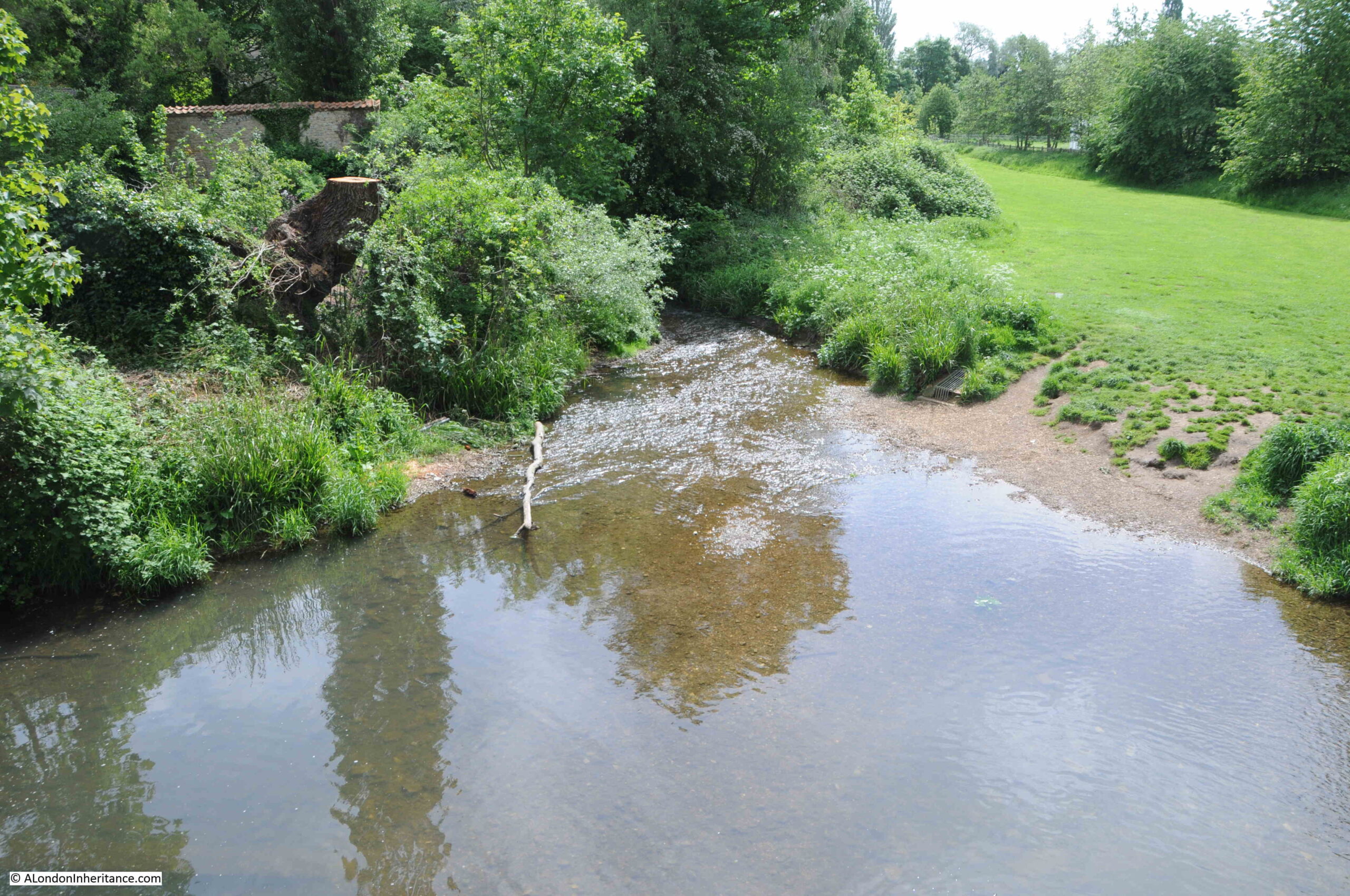
There is no way of knowing whether the procession carrying Eleanor’s body crossed the bridge. Geddington is today bypassed by the A4300, which crosses the River Ise over what must be the by-pass bridge mentioned in the 1932 book.
If the A4300 is not there, the bridge at Geddington is the only bridge over the river for a reasonable distance, so it is probably safe to assume that the procession did cross the bridge in 1290.
It would be interesting to know what the villagers of Geddington thought of the arrival of the procession with King Edward I, the body of Eleanor of Castile and the supporting party. Being December, they probably arrived after dark.
It must have been with a mix of fear and fascination that the villagers watched such a solemn procession arrive in their village, with the King of England, and the body of his dead Queen.
View from the bridge looking back to the cross in the centre of Geddington:
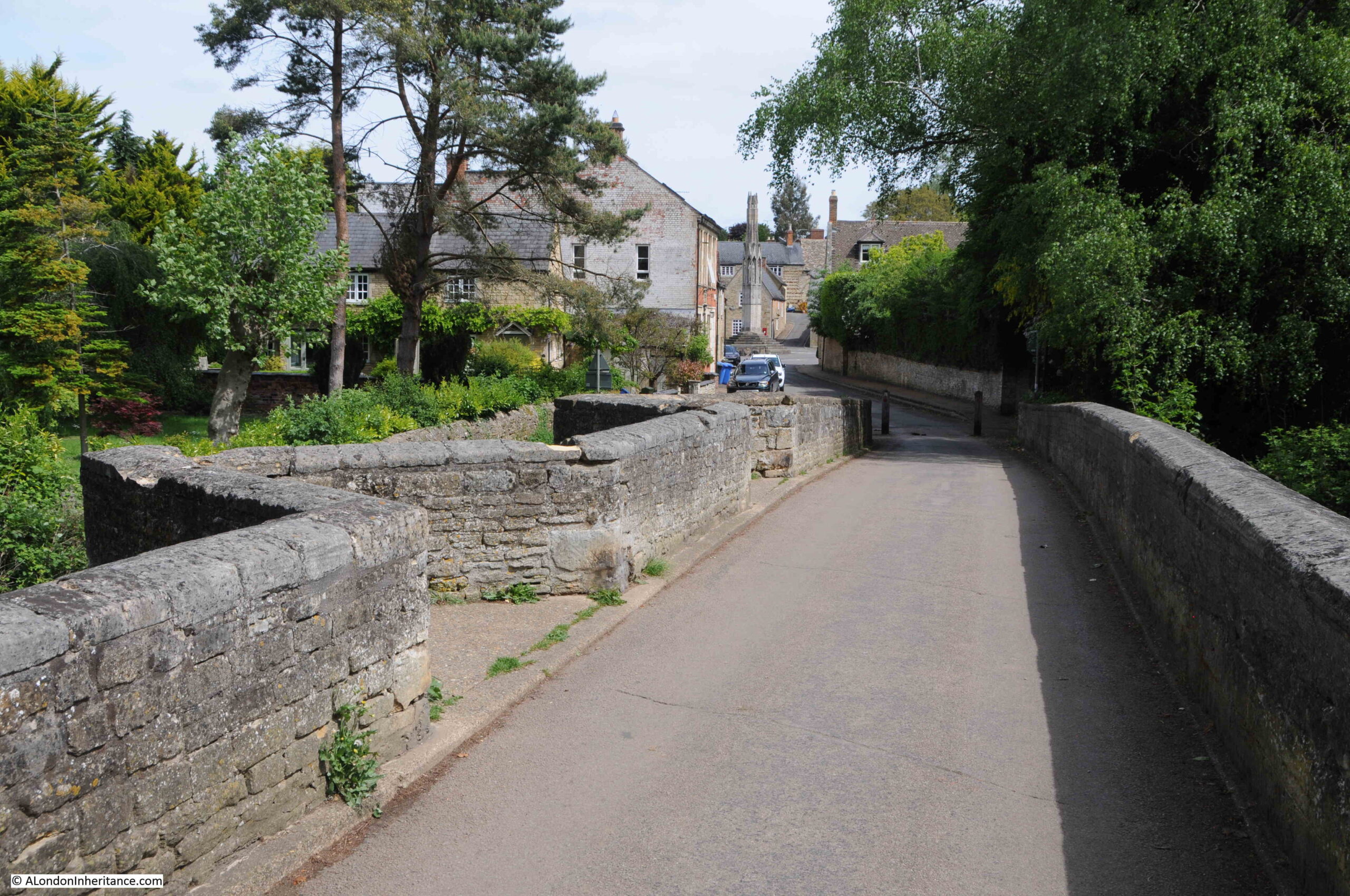
Geddington is a very different place to the location of the rest of the Eleanor crosses, and it has the Royal Hunting Lodge to thank for putting the village on the map with the superb 13th century cross.
The next post will continue the journey to Eleanor of Castile’s resting place at Westminster Cathedral.

Fascinating – great pictures. Thank you.
Very much enjoying this trip, bit upset about the squirrels though . Thanks Kate
Looking forward keenly to a photograph of Queen Eleanor’s final resting place “at Westminster Cathedral” – which wasn’t consecrated until 1903. I am greatly enjoying your journey: thankyou. It’s a real labour of love.
I very much enjoy your Sunday blogs and in particular the recent piece on Penton St and Chapel Market which i would walk through as a child every day on my way to school. i’m now living in a small village midway between Stamford and Geddington so your Queen Eleanor Cross quest strikes another chord. The Geddington Cross is indeed the best preserved of all the crosses and is well worth a visit as is the church of St Mary Magadalene which is open every day and usually offers a guided tour. The ancient bridge is still in use by cars but width-restricted so the 4x4s usually brave the ford. Looking forward to the account of the rest of your trip
Excellent as always, I look forward every week to this and poignant as I live just outside Lincoln. A contribution I would make is that the first cross was at Cross o Cliff Hill on the southern edge of Lincoln, it was lost for years then discovered having been unofficial repurposed as a small footbridge crossing a dyke.
This is such an interesting topic – thank you!! I recently visited Stamford and Grantham, and really wish I had read your piece before! Keep it coming!!
Absolutely Wonderful article. I feel like I was on the journey with you. Your photos are beautiful, and show an England that is fast disappearing. So glad these buildings still exist. Thank you.
So interesting. Thank you.
Such an interesting topic and now a journey following this route has joined my bucket list !
I’m enjoying this journey through history. It is a nice reminder of many places I haven’t visited for some time. And I don’t remember the bridge at Geddington! Oh dear.
Just one minor point – the pub sign over the road in Stamford isn’t quite unique. There is one in Asbourne, Derbyshire which advertises the Green Man & Black’s Head Royal Hotel. For obvious reasons there was a petition about it and the black head was removed from the grade II* sign by locals in 2020.
Yes, we spent a few hours there on our way home from Buxton in 2015 and were really shocked to see that! I’ve just looked at the photo I took and it did indeed have a wooden black man’s head on top, so that must be what was removed in 2020. When I saw the George one in this article it reminded me of Ashbourne straight away.
Have to disagree about Geddington being the best-preserved of the crosses. May have something to do with the fact that I live about 5 miles from the Hardingstone/Northampton cross! 😉
This is incredibly interesting! I love seeing such ancient buildings and structures. Thanks for posting this!
I have some pictures of The Beehive taken this morning with no leaves on the tree. If you would like them please give me an email address.
Ken
Very interesting. People may also be interested in my book, covering this route, The Eleanor Crosses, The Story of King Edward I’s Lost Queen and her Architectural Legacy.
Hi Decca, your excellent book was one of the books I read on the journey to the sites of the crosses. I featured the book in the last post, at the bottom of this page: https://alondoninheritance.com/cycling-around-britain/eleanor-crosses-the-end-of-the-journey-in-london/
Thank you very much! I am delighted you enjoyed my book and found it useful. It was great fun writing it.
Excellent post; – many thanks again.